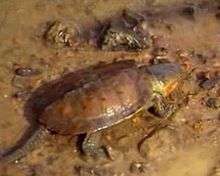Big-headed turtle
| Big-headed turtle | |
|---|---|
 | |
| Scientific classification | |
| Kingdom: | Animalia |
| Phylum: | Chordata |
| Class: | Reptilia |
| Order: | Testudines |
| Suborder: | Cryptodira |
| Family: | Platysternidae Gray, 1869[2] |
| Genus: | Platysternon Gray, 1831[2] |
| Species: | P. megacephalum |
| Binomial name | |
| Platysternon megacephalum Gray, 1831[2] | |
| Synonyms[3] | |
| |
The big-headed turtle (Platysternon megacephalum) is a species of turtle in the family Platysternidae from the Southeast Asia and southern China.[2] For Madagascar see Madagascan big-headed turtle.
Background
Previously considered a distinct family placed on occasion in "Kinosternoidea", it was later moved to the Emydidae. With the Geoemydidae being split off from these, it seems wisest to reinstate, at least for the time being, the Platysternidae. This, as well as the subfamily and the genus Platysternon, are monotypic.
Distribution
It is found in Cambodia, China, Laos, Myanmar, Thailand, and Vietnam.[2]
Behaviour

The big-headed turtle is known to readily climb over obstacles in and around rivers and fast streams, using its tail as a prop to extend the reach of its strong claws; it also uses its beak to assist in climbing.[4] It has been reported to climb trees and bushes. It is not a strong swimmer, and when swimming, this species occasionally arches its tail in the manner of a scorpion.[4] The big-headed turtle cannot pull its head in its shell. That being the case, it will not hesitate to use its powerful jaws to defend itself. It is a fish and snail eater.
Exploitation
The big-headed turtle is readily consumed in Asia and is frequently a market item. Hunters capture them on lines with baited straight pins, so this species is rapidly disappearing in the wild.[5]
Subspecies
- P. m. megacephalum, China, 1831[2]
- P. m. peguense, Myanmar and Thailand, 1870[2]
- P. m. shiui, Cambodia, Laos and Vietnam, 1987[2]
In addition, two other subspecies P. m. tristernalis (1984) and P. m. vogeli (1969) have been given, but may be invalid.[6]
References
- ↑ Asian Turtle Trade Working Group 2000. Platysternon megacephalum. 2006 IUCN Red List of Threatened Species. Archived June 27, 2014, at the Wayback Machine. Downloaded on 29 July 2007.
- 1 2 3 4 5 6 7 8 Rhodin 2010, pp. 000.107
- ↑ Fritz, Uwe; Peter Havaš (2007). "Checklist of Chelonians of the World" (PDF). Vertebrate Zoology. 57 (2): 264–265. ISSN 1864-5755. Archived from the original (PDF) on 2010-12-17. Retrieved 29 May 2012.
- 1 2 Kirkpatrick, David T. 1995. Platysternon megacephalum. Reptile & Amphibian Magazine, November/December 1995, pages 40 – 47. C/R. Archived May 22, 2011, at the Wayback Machine. Retrieved 2012-11-25.
- ↑ James E. Barzyk Turtles in Crisis: The Asian Food Markets. The article itself is not dated, but mostly refers to data in the range 1995-2000.
- ↑ Platysternon megacephalum Archived May 22, 2011, at the Wayback Machine.
- * Pritchard, D. 1979. Encyclopedia of Turtles. New Jersey: T.F.H. Publications, Inc. Ltd.
- Bibliography
- Rhodin, Anders G.J.; Paul van Dijk, Peter; Iverson, John B.; Shaffer, H. Bradley (2010-12-14). "Turtles of the World 2010 Update: Annotated Checklist of Taxonomy, Synonymy, Distribution and Conservation Status" (PDF). Archived from the original (pdf) on 2010-12-15. Retrieved 2010-12-15.
- Fritz, Uwe; Havaš, Peter (2007-10-31). "Checklist of Chelonians of the World" (PDF). Archived from the original (pdf) on 2010-12-29. Retrieved 2010-12-29.
External links
- Big-headed turtle (Platysternidae)
- (Chinese) Big-headed turtle
- (Spanish) Platysternon megacephalum
